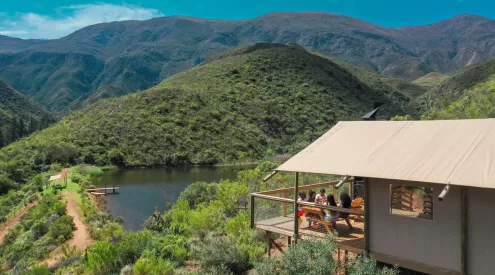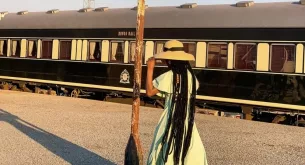She was no ordinary woman. Dressed in a billowing black gown, a string of white shells strapped to her chest, and vibrant woolen tassels hung from her waist. She stood swaying and murmuring. Eyes closed. Her solid frame propped up by a wooden stick.
I sat before her, huddled among a throng of local villagers, sitting on reed mats laid out across the dusty floor. We were gathered inside a small hut, made of cow dung and straw thatch. The air was thick with the smell of fermented sorghum.
Only that morning I had woken up in an old tudor-style hotel, planted firmly on the outskirts of Eshowe. Once the colonial capital of Zululand, Eshowe is set amid the leafy rural highlands of northern Natal. Graham Chennels, the cheery hotel-owner, is well connected with local Zulu chiefdoms. He suggested I join him at a sangoma healing ceremony, held in one of the nearby villages.
By afternoon I was in a different world, snaking through fields of sugar cane and climbing an horizon of sun-streaked hillocks. We rattled to a stop amid a cluster of mud huts, dust whipping into clouds above a cattle kraal. Met by an elder who spoke broken English, I was steered through a swarm of excitable children and instructed to remove my shoes, before dipping my feet into a plastic bowl of murky water.
Inside the hut, the sangoma welcomed me into the ceremony, offering sips of homemade brew and dishing out sweets wrapped in shimmering plastic. Light flickered through cracks in the wall and a crowd of dimly lit faces gazed intensely at the woman before. She was dancing frantically, thumping her cane into the ground. Surrounding her were her apprentices, one of who – a small man with dwarfed features, began beating an animal skin drum. Everyone started clapping, louder and faster, with the women sounding a shrill chorus of ululating.
The sangoma was working herself into a trance. In this extrasensory state she would be possessed by ancestral spirits, and able to receive guidance for patient’s problems. Traditionalists here consult sangoma’s like we might a psychic, for direction on the uncertainties in life like wealth and career choice. Sangoma’s also perform a holistic and symbolic form of healing. Whether for physical ailments or social disharmony, remedies administered through ritual practices and the giving of muti (herbal medicine), are embedded in the belief that ancestors protect and guide the living.
Part curiosity and part alarm at the woman next to me, (who had begun talking in tongues and rolling around on the floor), urged me to stand up and join the queue of people waiting in line for advice. Consultations are received by donation, with notes safety-pinned to a woven hat decorating the sangoma’s head. Fifty Rand was all I had to offer. It made me feel sheepish next to the collection of two hundreds flapping around her ears. People in the village save up for months to visit a sangoma, her advice is considered sacred and revered with the utmost respect.
My problem was relatively simple. I needed to know whether a future work project would be successful or not. The solution, apparently, was in a bag of corn flour and a white handkerchief. If I was to achieve my goals, I must eat a handful of ground maize and wipe my face with the blessed piece of cloth.
Two months of hard work later, and I’m still waiting to find out whether success will reign. I don’t expect a miracle. But superstition has a funny way of creeping in on us, especially when the future looks glum. I can’t help but feel tempted by that now-filthy hankie and stale bag of miele powder, stored safely in the drawer of my bedside table.


















